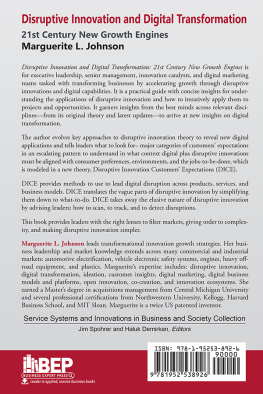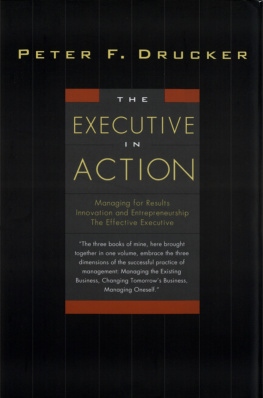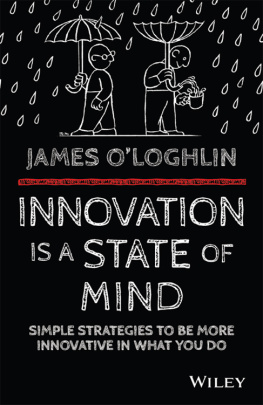CONTENTS
Guide
Worth
The Innovative Executive
Leading Intelligently in the Age of Disruption
Bella Rushi
Foreword by Magnus Penker
Wall Street Journal and USA Today Bestselling Author
To my parents and my amazing kids
My parents taught me to be adaptable and always kind, and they helped me find the courage to follow my heartthank you.
Zara, Rahul, and Ravithank you for the love, laughter, and support you have given me each and every day.
FOREWORD
THE INNOVATIVE EXECUTIVE is a highly practical handbook on how to succeed with market-driven innovation to create chain reactions across the board. In a rare personal way, Bella Rushi walks you step by step how to build a culture of innovation driving sustainable growth. Follow her from a childhood of working with her dad as a street vendor to becoming an international extern and top consultant in innovation.
With firsthand experience explained using well-known examples grounded in world-class methodology, Bella Rushi opens up the doors to understand what is really important and how to use those insights in a daily practical perspective. Get acquainted with marketing, communication, narrative, testing with hypotheses, and when to pull the plug or not. It is a pleasure to recommend this book to anyone who wants to understand more and get practical insights into innovation management. Get ready to generate chain reactions and take your organization to the top with Bella Rushi in The Innovative Executive.
Many business leaders will recognize themselves in the examples and will find themselves rooting for Bella to succeed in her work harnessing innovation to turn their companies around. This book provides not only insights but defines a proven framework as a conversation versus a set of rules to follow. The Innovative Executive presents an ongoing discussion between readers and the author of what new practices can be integrated with effective decision-making to become an innovative business leader.
Bellas book is not only based on her own experiences, but its the perfect illustration of how one needs to be able to pivot on a moments notice depending on what the days events bring forth in business. She uses the street vendor analogy as an ongoing theme in the book to demonstrate in todays ever-changing marketplace that business leaders need to develop the sharp mindset of a street vendor.
Bella shows the connection between the entrepreneurship mindset and the importance of innovation. She showcases how companies grow, especially in difficult environments, and how that growth increases over time. Bella outlines various methods that contribute to collecting new customer insights, creating new market segments, and outlining ways to maximize customer engagement strategies.
The timing of The Innovative Executive is perfect. Many leaders will change the ways they conduct business over the next five years, and only a handful of companies are equipped to face the challenges ahead. Bella insightfully builds on the examples from her own experiences and opportunities to introduce the strong capabilities needed to capture new growth. She suggests that embedding innovation practices is key to long-term growth. She also makes a very strong case for making data-driven decisions with the customer top of mind. Youll learn new capabilities such as being more customer-centric, adapting your core focus to meet shifting customer needs, addressing new opportunities through collaboration, reevaluating your business model, and remaining competitive through sustainability initiatives. This book will help you solve seemingly impossible challenges around innovation-led growth and forgo playing it safe to take more urgent actions.
Magnus Penker is the author of Play Bold: How to Win the Business Game Through Creative Destruction. He is an Innovation Thought Leader, CEO of Innovation360 Group, and a speaker in prestigious global forums and events such as The Global Peter Drucker Forum.
AN INVITATION
The seduction of safety is always more brutal and more dangerous than the illusion of discomfort.
R OBIN S HARMA
EVERY BUSINESS LEADER understands that innovation is vital to an organizations successperhaps even to its survival. Life will always throw curveballs at youthe mass disruption of the COVID-19 pandemic serves as a stark reminder of this factand the ability to innovate is what separates those businesses that survive from those that do not.
So how can a leader foster the culture of innovation that will someday be needed to ensure the survival of their business?
The path to innovation is a mindseta willingness to promote creativity and precision. Its a structured discipline that requires pilot testing, experimentation, and meticulous data collection. It requires a sense of purposea drive to reach your goals combined with a capacity to pivot toward new ones when necessary. This journey creates new learnings, new experiences, new bonds, and new products and services, and with each step on the journey you become more confident, more flexible, and more adaptable to uncertain environments. And that flexibility is what allows you to thrive.
This understanding is what has enabled many business leaders to guide their organization to a sustainable level of new success: Fuji Films, Apple, Nintendo, LEGO, Netflix, Starbucks, and Marvel, to name just a few.
Change is hard, not just in our organizations but also in environments. Many companies constantly operate in a reactive mode and struggle to accomplish their goals. The leaders of these organizations are bombarded by confusing market signals and trends such as disruptive political events, the pandemic, and relentlessly rapid advances in technology. They have little clarity about which direction they should take, and theyre terrified of making wrong decisions. Theyre inundated with overwhelming amounts of data, and they cant tell which data should be trusted. Then when change happens, the organizational culture becomes resistant and doubtful. This leads to unproductive and siloed departments.
Handling a crisis is not a onetime effort; it requires experience, flexibility, adaptability, and strong capabilities in your organization to move forward.
The goal of this book is to fill the following gaps in your understanding:
- What do companies need from their leaders today?
- What can we do to uncover new possibilities to go to market and to create new processes and new customer experiences?
- What is the real challenge companies face when it comes to innovation?
This book looks at three levers that business leaders can use to spur innovation: their business model, technology, and collaboration with external parties. It discusses the individual effects of these levers on organizational processes to make them more adaptable. It also analyzes the strengths of specific combinations of organizational capabilities, including those that are technology oriented, internally oriented, externally oriented, and those that integrate all these levers.
Each chapter provides insights drawn from practical case studies in which companies have used their capabilities to gain customer insight, build market share, and create long-term growth. I argue that prioritizing innovation is an important discipline that a company can add to its existing processes, business model, and customer experience. I explore the principles and capabilities of innovation and show how it can be embedded into a structured approach to become more adaptable and grow your company in a variety of highly competitive environments.








